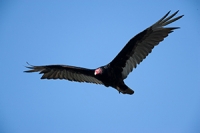The turkey vulture appeared so utterly regal that it seemed almost unfathomable her presence could create a stench potent enough to raise the dead. How cruel for a creature already hindered with looks only a mother could love!
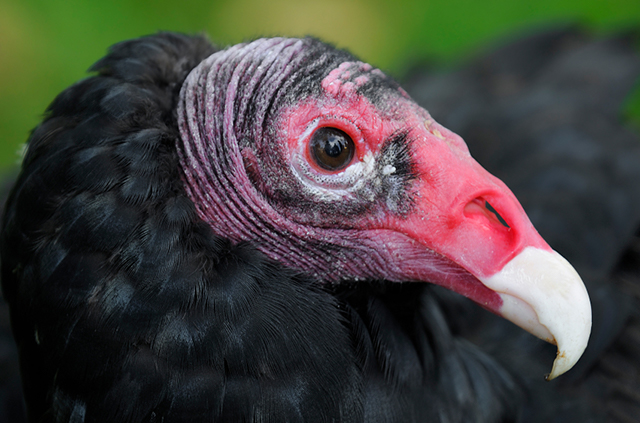
Turkey Vulture headshot by Holly Kuchera/iStockphoto.com
Yet, there is simple reason for all this. The turkey vulture smells like rot partly because it eats, well, rot. The turkey vulture is a scavenger, who rather than kill prey, eats nature’s left-overs. Its stomach is strong enough to easily digest the diseased and spoiled carcasses it consumes, disposing of nature’s unwanted rot and helping to keep disease in check in our environment.
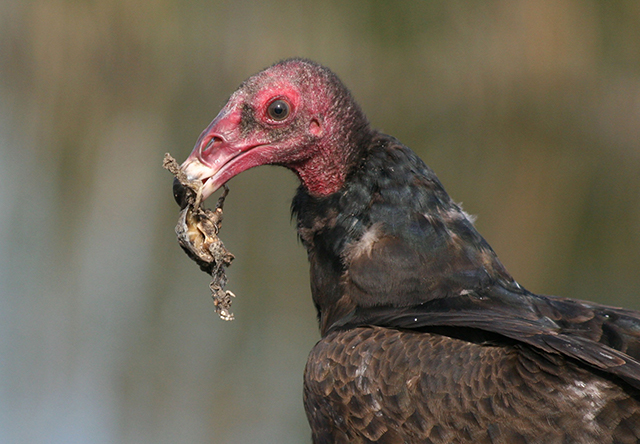
First-year. San Joaquin Marsh, Orange Co., 3-07 © This email address is being protected from spambots. You need JavaScript enabled to view it..
If that isn’t enough to convert you to becoming a vulture lover, there is plenty more! This native bird also has an incredible sense of smell and sight. Equipped with enlarged nostrils and heightened long-distance sight, the turkey vulture can detect gases escaping from decaying flesh from quite a distance. Once it locates food, it uses its large hook-shaped bill to rip into flesh and tear through hide as thick as a cow’s. And while this may seem raptor-like in behavior, the vulture is actually more closely related to storks than hawks. Unlike raptors, a vulture’s foot is rather weak, designed for hopping rather than catching food. Like storks, the turkey vulture’s odd-looking red head is mostly featherless, making it easier for putrid food matter to slough off while eating.
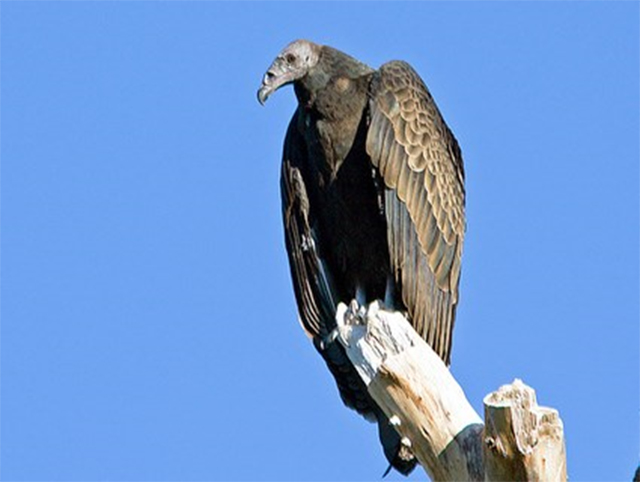
Immature Turkey Vulture © Lois Manowitz, AZ, Pena Blanca Lake, Nogales, September 2010
Although the turkey vulture lacks a syrinx (a bird voicebox), it is still, amazingly, a very social bird. They typically roost silently in large communal groups with other vulture species on dead trees or tall polls, using hisses and grunts to communicate only when necessary and breaking away only occasionally to eat. They are found in nests only during the breeding season when they use hollowed out logs, rock cavities, or even caves to lay their eggs. Average clutches of two eggs are incubated by both females and males and fledgling vultures will remain close to their parents for an extended period. They don’t acquire their red heads until the age of 1 or 2 years.
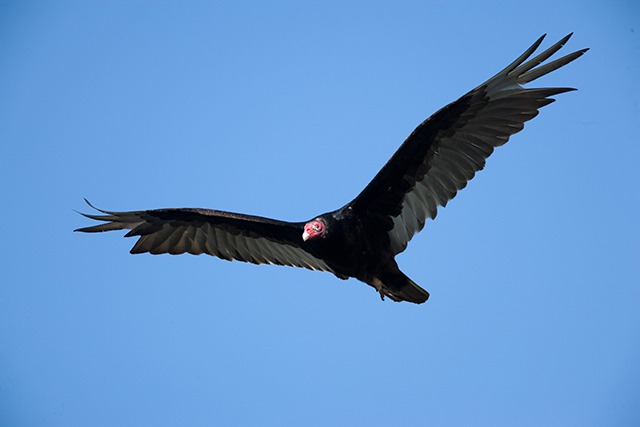
Photo by MDC Staff, courtesy Missouri Department of Conservation
The fascinating turkey vulture is native to Wisconsin and found commonly throughout woodland and open area habitats. It’s the most common vulture in the United States and differentiated from the less common black vulture by the light gray coloring found on the underside of the entire wing (turkey vulture) rather than just the tips (black vulture). The turkey vulture soars on heat thermals to avoid frequent flapping (and conserve energy) and holds its wings at an angle slightly above its head in flight. This creates a recognizable V-like appearance that, when viewed head on, makes it distinguishable from raptors soaring at a distance in similar habitat.
Speaking of habitat, this leads me back to the story I mentioned about spotting our Riverside Park turkey vulture by the river. Remember how I told you she stunk partly because of what she ate? Well, there’s more to it than that; perhaps one of the oddest creature curiosities that exists! Its odiferous aroma can be attributed to its taxonomy. Okay, perhaps rather indirectly. A turkey vulture’s close ancestry to a stork, means that it also shares some common characteristics. One of those is temperature regulation achieved by defecating/urinating on one’s own legs. The process of urohydrosis essentially lowers body temperature as cooler air moves across the moistened surface of the soiled legs. Think of it as unique bird sweat. Combine this with a partially-digested foul-smelling substance that the vulture vomits in defense at its predators (which can cause burning and discomfort due to the substance’s acidic nature), and the odor multiplies two-fold. Imagine what you might smell like if you consumed a diet of rot, defecated/urinated on your own body (consistently without bathing), AND spilled residual vomit all down your front every time you felt threatened. Oh, and imagine yourself with no hands to help clean yourself. No wonder our turkey vulture wasn’t the most pleasant smelling bird in the forest that morning!
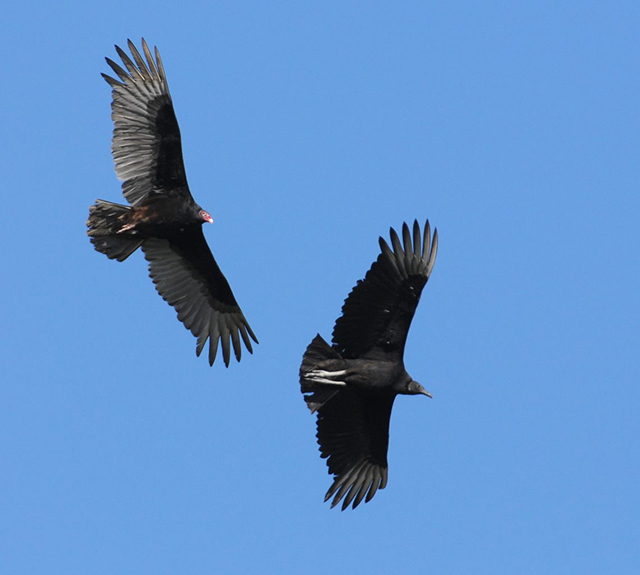
Turkey Vulture and Black Vulture in flight
Despite the lengthy list of turkey vulture’s amazing curiosities, there are still plenty of people who think of vultures as the enemy. Some ranchers believe that vultures kill their livestock because of their scavenging nature. Additionally, some farmers also believe that vultures pass certain diseases to livestock. This has been refuted because of the vulture’s curious, sterilizing digestive system. Not all are haters though. Some Native American tribes view vultures with reverence. They think of turkey vultures as “peace eagles” because vultures never kill and always recycle. In fact the root of its genus, cathartes, comes from the word catharsis because to be eaten by a vulture after death is believed to cleanse and release one’s soul. Then there are those of us who just find turkey vultures fascinating and appreciate them all the more for their numerous oddities. Very special, creepy creatures indeed!
Fun Facts:
And you thought your kid brother had an iron stomach? Imagine possessing the ability to consume a spoiled, disease infested piece of meat and rid it from your body with no trace of disease or ill effects. Scientists have been trying to understand the biology behind the strength of the vulture gut for years hoping the process could be adapted to human science.
Make the most of what you’ve got. When food supplies are scarce, vultures will forgo meat for vegetables, grasses, pumpkins, and seeds. However, true to its nature, it still scavenges for these items.
You say potato… Although most people call the big black bird soaring on heat thermals “vulture”, many people still use the older common name “buzzard”.
Who are you calling turkey?! Don’t get confused by its common name. The turkey vulture is not related to a wild turkey and only earned its common name because of its red, bald face which resembles that of a turkey.
Age is just a number. The oldest documented wild turkey vulture lived 16 years and 10 months. Yeah, but what does that equate to in vulture years?
*This article was written using David Allen Sibley’s Field Guide to Birds of Eastern North America, the phone app iBird Ultimate by the Mitch Waite Group, and the websites www.Audubon.org, www.allaboutbirds.org, and www.eekwi.org,


